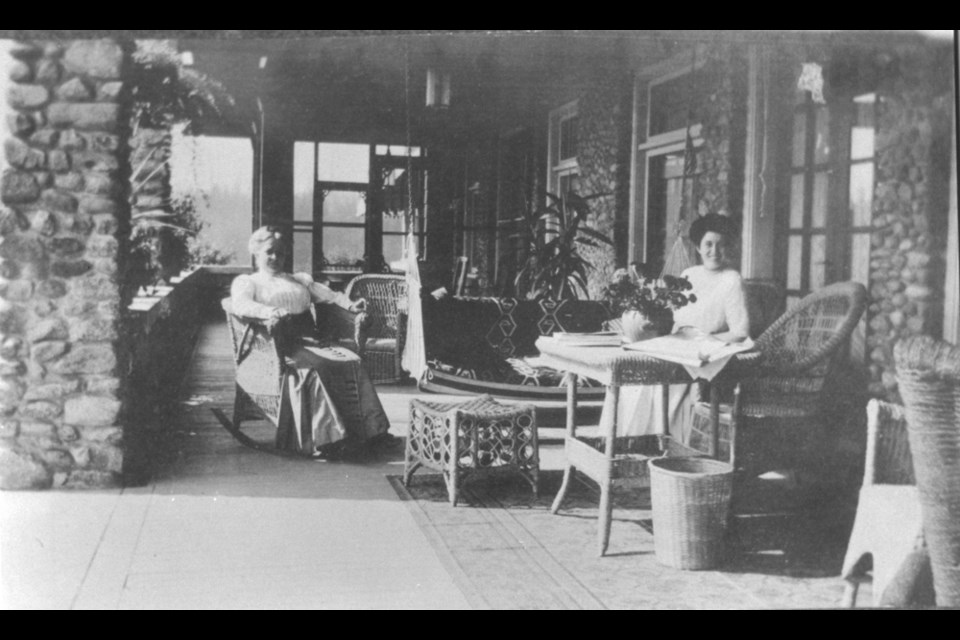To some, the Burnaby Art Gallery is a mystery. Perched near Deer Lake and surrounded by lush gardens, the heritage home known as Ceperley House – originally Fairacres – has always been the subject of much interest.
But it is not a mystery to Polly Svangtun, one of the early members of the Burnaby Art Society.
“We kept pushing for an art gallery and finally we got the place where we are now, Ceperley House,” she says of the society. “And we saw it after the squatters were thrown out and before everything was cleaned up.”
Svangtun joined the society when a friend mentioned it to her, just as the members were beginning to look for a permanent location.
In 1966, the society lobbied the City of Burnaby to purchase Ceperley House as a gallery space for the society. They were successful, and in 1967 the gallery became theirs. That is, once the frat boys moved out.
Simon Fraser University’s Delta Upsilon Fraternity had been using Ceperley as a fraternity house since 1965. The members had abused it quite badly and protested their eviction with a bonfire.
“They had lit a fire on the floor of the billiard room,” Svangtun says, adding it was up to the society to restore the heritage home. “The third floor had the most exotic paintings on the walls that you could imagine.”
Ceperley House had to be renovated and repaired before the gallery could open.
“I can remember spending a long time taking the white paint off the balustrade upstairs, which is a really beautiful wood,” she says.
Today, the house is beautifully restored and still hosts events, such as the 50th anniversary cocktail reception taking place this week.
The gallery is celebrating its 50th anniversary with a special exhibition, The Ornament of a House: 50 Years of Collecting.
Curator Ellen van Eijnsbergen and assistant curator Jennifer Cane recently met with the NOW to discuss the 50th anniversary and their time with the gallery.
Van Eijnsbergen chose to work at the Burnaby Art Gallery because she was impressed with its reputation, but also, in part, because of the space itself.
“One of the reasons I was drawn to this place is because it was a beautiful site, it’s a beautiful home, and the gardens – it’s really a lovely place,” she says.
Van Eijnsbergen came on as curator four years ago after working at the Evergreen Cultural Centre in Coquitlam.
“The Burnaby Art Gallery is really well known within the metropolitan art community as a really, really good gallery as far as the types of exhibitions they do, publications, and 50 years of history, so it’s got a really solid, strong background,” she says. “And I’ve always really admired what they do at the gallery.”
Cane agrees.
“Not every local gallery has a collection, and the collection is really large here, with more than 5,000 works,” Cane says. “And its specialization of works on paper is really unique. There’s nothing else like it in Canada.”
Cane, who began working at the gallery as a student nine years ago, now manages the collection.
The gallery’s publications also have a strong reputation, according to Cane, with the gallery’s annual catalogue going out to 125 libraries across Canada.
The gallery has accumulated its collection through donations and a small acquisitions budget, according to van Eijnsbergen.
Its mandate is to focus on works on paper, she adds, such as prints, photos, acrylics on paper and more. They acquire between 100 to 150 pieces for the collection each year, with about 10 purchased by the gallery.
This summer’s exhibition showcases 50 works from the gallery’s collection.
The exhibit takes its theme from the Ralph Waldo Emerson quote carved in the mantle of the billiard room, “The ornament of a house is the friends who frequent it.”
Fifty friends of the gallery – including donors, artists who have shown at the gallery, and former curators – have each selected one work that resonates with them.
The pieces were chosen from 100 pre-selected options, according to van Eijnsbergen. The book accompanying the exhibit, The Ornament of a House, shares the reasons why each piece was chosen.
The exhibit also includes tables of archival documents and newspaper clippings, she adds.
The gallery is holding its 50th anniversary cocktail reception on Thursday, July 13 at 7 p.m. There will be live music by Van Django and the signature cocktail will be the Ceperley Sipper.
For more information on the 50th anniversary exhibit and the gallery itself, go to www.burnabyartgallery.ca.
If these walls could talk: Key dates in the history of Ceperley House
The home of the Burnaby Art Gallery has had many different owners and occupants, as well as visitors and contributors to its long history.
1909 – Grace and Henry Ceperley buy a strawberry farm from George Clayton, with the intention of building a retirement estate.
1911 – Fairacres, designed by English architect R.P.S. Twizell, is built.
1917 – Grace Ceperley dies, leaving the home to her husband. Her will stipulates that proceeds from the eventual sale of the home be used to build a playground in Stanley Park.
1922 – Former Vancouver Mayor Frederick Buscombe buys Fairacres.
1939 – Benedictine monks from Mount Angel, Oregon, buy Ceperley House and turn it into a monastery.
1954 – The house is sold to a U.S.-based cult, the Temple for More Abundant Life.
1958 – The Burnaby Art Society is formed.
1965 – Fairacres becomes home to Simon Fraser University’s Delta Upsilon Fraternity.
1966 – The City of Burnaby purchases the property, having purchased land near Deer Lake previously.
1967 – The Burnaby Art Society establishes the Burnaby Art Gallery at Fairacres, after much fundraising and hard work to get the gallery open.
2017 – The Burnaby Art Gallery celebrates 50 years at Ceperley House, by far the most long-term resident in the house’s history.



